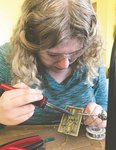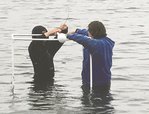Four students from the Port Townsend Science, Technology, Engineering and Math Club have demonstrated how they could apply their technological know-how to medical science, underwater exploration and …
This item is available in full to subscribers.
We have recently launched a new and improved website. To continue reading, you will need to either log into your subscriber account, or purchase a new subscription.
If you had an active account on our previous website, then you have an account here. Simply reset your password to regain access to your account.
If you did not have an account on our previous website, but are a current print subscriber, click here to set up your website account.
Otherwise, click here to view your options for subscribing.
* Having trouble? Call our circulation department at 360-385-2900, or email our support.
Please log in to continue |
|


Four students from the Port Townsend Science, Technology, Engineering and Math Club have demonstrated how they could apply their technological know-how to medical science, underwater exploration and special education.
A team made up of one high school student, two middle school students and a grade school student scored three first-place awards, one second-place award and received cash prizes at the 2018 Washington State Science and Engineering Fair in Bremerton, returning with several awards each.
One student was nominated to the top honor of moving onto the Broadcom Math, Applied Science, Technology, and Engineering for Rising Stars competition. The top 10 percent of sixth-through eighth-grade students from across the country participate in that competition.
As it stood, the PT STEM Club was the only group of students representing Jefferson County at the March 23-24 fair, for which more than 700 students from across the state took part.
Nathaniel Ashford, an eighth-grade student in his seventh year of participating in the fair, presented the project "Wreck Hunting with Magnetometers." He earned not only a second-place award in mechanical engineering, but also an "Adventures in Science" award and a "Do Real Things" award.
Nathaniel was inspired by claims of debris from a train wreck in Lake Crescent, which he planned to search for with a remotely operated underwater vehicle. However, further research has led him to conclude it was a power shovel being transported on a train car that tumbled into the lake instead.
"Magnetometers sense anomalies in the Earth's magnetic field," Nathaniel said. "This summer, I'll be heading to Lake Crescent, and whether it's a train wreck or a power shovel that's on the water, I intend to find it."
Ella Ashford, an 11th-grade student in her eighth year of participating in the fair, presented the project "Prototyping an Asthma Early Warning Device." She earned not only a first-place award in biomedical engineering, but also a Wolfram Math Achievement Award.
Last year, Ella began writing a computer program for an early warning system for asthma attacks. The program could monitor a patient's vital signs and use the data to predict possible attacks.
This year, Ella built the sensors to monitor a patient's temperature, heart rate, respiratory rate and other signs. Next year, she hopes to integrate the computer program and the sensors into a working prototype.
"I've been working on asthma-related projects for seven years," Ella said. "I partnered with folks from the hospital and a retired programmer named Otto Smith."
Everest Ashford, a sixth-grade student in his sixth year of participating in the fair, presented the project "A Language for Aphasia." He earned not only a first-place award in social science, but also the Mildred A. Misic Memorial Award.
Everest has been diagnosed with aphasia himself, and he compared it to similar linguistic and symbolic learning disabilities, such as dyslexia. Everest worked with speech pathologists and special education instructors to design an "alphabet" of shapes helping students with aphasia transition into reading and writing the modern English alphabet.
"I have a hard time reading, because I sometimes flip around the letters, or start reading from the wrong side of the page," Everest said. "I created 12 shapes that can translate into letters. This can help identify people who have disabilities like aphasia. And if you use the shapes long enough, they're designed to fade out and become the letters they stand for."
Ayden Ratliff, a fifth-grade student in his second year of participating in the fair, presented the project "The Manipulator." He earned not only a first-place award in mechanical engineering, but also the Margaret Lugg Memorial Award and the Original Math and Science Award. He was also nominated to the national level of Broadcom MASTERS (Math, Applied Science, Technology, and Engineering for Rising Stars).
Ayden first used the pneumatic manipulator, a gas-powered appendage for gripping and turning objects, on his underwater robot last year. He explained how he arrived on its three-pronged appendage design because "it can grab objects from any angle."
Ayden used computer-aided design and a 3-D printer to create the "fingers" of the manipulator, which he believes allowed him to use less material and produce the components of the manipulator faster. All four students agreed the firsthand lessons they have received, through experience, about the scientific process were invaluable.
Ella added the PT STEM Club is already accepting applications for student demonstrators for the fourth annual "Mini Maker Fair" in October. In the meantime, the team is gearing up for a remotely operated vehicle competition at the Weyerhaeuser King County Aquatic Center in Federal Way.